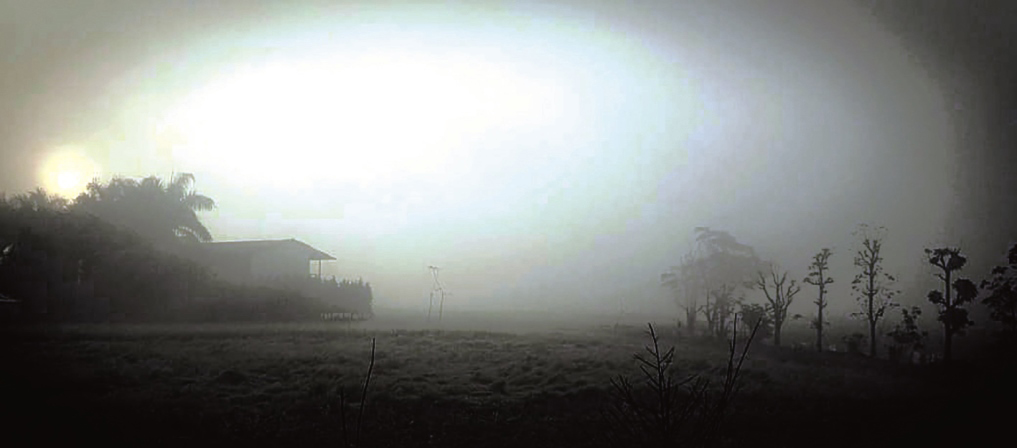Rising cold, air pollution raising virus risks

By A Staff Reporter
Kathmandu, Dec. 5: As the temperature plummets throughout Nepal, many worry the impact of the increasing cold on the ongoing COVID-19 pandemic.
Even Nepal Telecom has slightly altered its usual COVID-19 centric user caller ring back tone (CRBT), this time cautioning the masses to stay safe against the cold and a host of different ailments that comes with it.
The beginning of winter marks a surge in influenza cases throughout the country.
Dr Santa Kumar Das, Pulmonologist, and COVID-19 focal person at Tribhuvan University Teaching Hospital, has already noticed a spike in the number of people visiting the hospital, mostly due to respiratory illnesses since November.
As Dr. Das purports, in a pre-COVID-19 world, people shrugged off their cough and cold ailments as nothing more than seasonal flu. “Since the pandemic, though, people are becoming increasingly fearful, which has further increased traffic here at the hospital,” he added.
However, with winter already here, the growing fear among the masses isn’t unwarranted. It’s common knowledge among health professionals that viruses peak at the outset of the winter season. According to Dr. Das, a drop in temperature means low humidity; the air gets dirtier thereby increasing the risk of respiratory illnesses.
State of Global Air report 2020 placed Nepal among the top 10 countries with the highest outdoors PM2.5 levels in 2019.
Health experts believe that both cold and the increase in pollution will lend a double blow thereby exacerbating the already pertinent health problems in Nepal such as pneumonia, influenza and COPD not to mention the COVID-19.
Air pollution and declining temperatures might prove to be a heyday for SARS-COV-2.
“Some studies have shown that coronaviruses stay stable for a long time at low temperatures,” said Dr. Sher Bahadur Pun, Head of Clinical Research Unit of Shukraraj Tropical and Communicable Diseases Hospital, which means that if the virus could stay for about three days in harder surfaces such as glass during hotter seasons, it can survive for over seven days in colder conditions.
Likewise, during winter, people spend more time indoors with the windows sealed, making them more likely to breathe the same air as someone who has the flu or the virus. As per Dr. Pun, ventilation will be the key to prevent an infection like COVID-19 and flu.
While it’s common for households to burn coal during winter, indoor pollution such as that will increase COVID-19 risks. “Apart from keeping windows open, face masks should be worn at all times in public including indoors when others are present regardless of the distance between people,” stresses Pun.
Prakash Ghimire, a professor of Microbiology at Tribhuvan University suggests getting flu and pneumonia vaccinations. "The death rate of influenza is five per cent and the coronavirus death rate is one to three percent. If both the pathogens are
coupled together, there is an additional risk," he said, emphasising on the use of available vaccination to minimise flu during the pandemic. “It is best to vaccinate asthma
patients against pneumonia every three years,” further added Ghimire. Moreover, days are shorter during the winter, and lack of sunlight leads to low levels of vitamin D, both of which require sunlight for their generation.
This compromises the immune systems, which in turn decreases ability to fight the virus, explains Dr. Pun, who encourages taking Vitamin D supplements.
“However, adults shouldn’t consume more than 100 micrograms, while children below 10 shouldn’t take more than 50 micrograms per day,” informs Dr. Pun.
In addition to the flu season and concerns about indoor gatherings, health experts predict increase in COVID-19 contagion.
However, bracing for the winter and surge of virus by adhering to health protocols, minimising gatherings and maintaining social distancing will help curb the situation.
Recent News

Do not make expressions casting dout on election: EC
14 Apr, 2022
CM Bhatta says may New Year 2079 BS inspire positive thinking
14 Apr, 2022
Three new cases, 44 recoveries in 24 hours
14 Apr, 2022
689 climbers of 84 teams so far acquire permits for climbing various peaks this spring season
14 Apr, 2022
How the rising cost of living crisis is impacting Nepal
14 Apr, 2022
US military confirms an interstellar meteor collided with Earth
14 Apr, 2022
Valneva Covid vaccine approved for use in UK
14 Apr, 2022
Chair Prachanda highlights need of unity among Maoist, Communist forces
14 Apr, 2022
Ranbir Kapoor and Alia Bhatt: Bollywood toasts star couple on wedding
14 Apr, 2022
President Bhandari confers decorations (Photo Feature)
14 Apr, 2022










